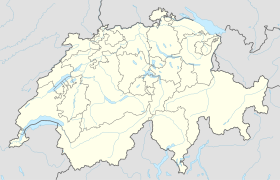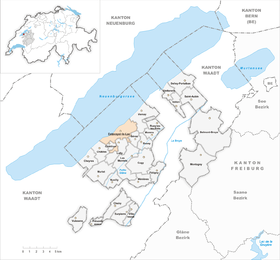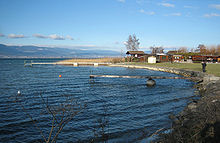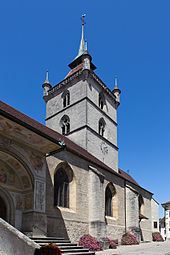Estavayer-le-Lac
| Estavayer-le-Lac | ||
|---|---|---|
| State : |
|
|
| Canton : |
|
|
| District : | Broye | |
| Municipality : | Estavayer | |
| Postal code : | 1470 | |
| former BFS no. : | 2015 | |
| UN / LOCODE : | CH ELL | |
| Coordinates : | 554894 / 188934 | |
| Height : | 448 m above sea level M. | |
| Area : | 8.93 km² | |
| Residents: | 6291 (December 31, 2016) | |
| Population density : | 704 inhabitants per km² | |
| Website: | www.estavayer.ch | |
|
Old town of Estavayer-le-Lac |
||
| map | ||
|
|
||
Estavayer-le-Lac (French pronunciation: [estavaje l (ə) lak] ; in the Franco-Provencal local dialect Thavalyi-le-Lé or [tavaˈji lə ˈle] ) is the eponymous town of the municipality of Estavayer im Swiss canton of Friborg and the capital of the Broye district . The German name Stäffis am See is rarely used today. The historic town is located on the south bank of Lake Neuchâtel and forms the regional and economic center of the Friborg part of the Broye region.
Until December 31, 2016, Estavayer-le-Lac was an independent political municipality ; on January 1, 2017, Estavayer-le-Lac merged with the former municipalities of Bussy , Morens , Murist , Rueyres-les-Prés , Vernay and Vuissens to form a new municipality Estavayer .
geography
Estavayer-le-Lac is 448 m above sea level. M. in an exclave of the canton of Friborg, 25 km west of the canton capital Friborg (as the crow flies). The small town in the north-western Freiburg Central Plateau extends slightly above the south bank of Lake Neuchâtel and on the subsequent plateau of the broad ridge that separates Lake Neuchâtel from the Broye plain .
The area of the 6.4 km² municipal area comprises a section on the south-eastern shore of Lake Neuchâtel (around 3.5 km lakeshore length). In the area of Estavayer-le-Lac, the lake has a flat, up to 500 m wide shoreline. Especially in the north-eastern section, this is made up of a belt of reeds and swamp forest, in which the Grande Gouille pond is located. These zones are part of the Grande Cariçaie nature reserve .
This is followed in the south by a 10 to 40 meter high steep step, which is criss-crossed by sandstone cliffs at La Corbière . Above the steep slope, the terrain merges into a wide plateau with only very minor differences in relief. There are two above-ground rivers here, the village stream of Lully, which flows into Lake Neuchâtel to the west of the boat harbor, and another small stream that overcomes the steep step between the plateau and the edge of the bank near La Corbière with the Saut de la Pucelle waterfall . The highest peaks of Estavayer-le-Lac are 488 m above sea level. M. at the Toutvent homestead and on the Les Esserpis corridor on the eastern municipal boundary . In 1997, 31% of the municipal area was in settlements, 6% in forests and woodlands, 59% in agriculture and a little more than 4% was unproductive land (reed belt).
The hamlet of La Corbière ( 465 m above sea level ) in the north-east of the municipality on the plateau above the escarpment and various individual farms belong to Estavayer-le-Lac . The neighboring communities of Estavayer-le-Lac are Vernay , Sévaz , Les Montets , Lully , Châbles and Châtillon .
population
| year | Residents |
|---|---|
| 1850 | 1323 |
| 1900 | 1636 |
| 1910 | 1958 |
| 1930 | 2021 |
| 1950 | 2452 |
| 1960 | 2583 |
| 1970 | 3439 |
| 1980 | 3662 |
| 1990 | 3808 |
| 2000 | 4437 |
| 2016 | 6291 |
With 6,291 inhabitants (as of December 31, 2016), Estavayer-le-Lac was one of the medium-sized communities in the canton of Friborg. The population has increased slowly but continuously since 1900. Significant population growth rates were recorded at the beginning of the century, during the 1970s and since 1990. At the beginning of February 2009 a population of 5000 was reached. The settlement area of Estavayer-le-Lac has grown together almost completely with that of the neighboring municipality of Lully .
With regard to the age distribution, according to statistics from 2000, the 20 to 64 year olds form the largest population group with 57.9%, followed by the under 20 year olds with 28.7% and the over 64 year olds with 13.3%.
Of the community's residents, 81.2% are French-speaking, 5.8% German-speaking and 3.7% speak Albanian (as of 2000). The remaining 9% are spread across different language groups, with Spanish and Italian making up the largest percentage. The proportion of foreigners is around 24% and is thus well above the average for the canton of Friborg (15%).
The population of Estavayer-le-Lac is predominantly Catholic. In 2000, 64% of the residents were Catholics, 13% Protestants, 8% belonged to other faiths, 7% were non-denominational and there is no reliable information about the rest.
politics
legislative branch
The legislative authority is the General Council (Conseil général), elected every five years by the voters of the municipality of Estavayer-le-Lac. The 50 MPs are elected by proportional representation. The tasks of the General Council include the budget and invoice approval, the definition of the municipal regulations and the control of the executive.
The distribution of seats in the 2006 elections was as follows:
executive
The executing authority is the municipal council (Conseil communal). It consists of nine members and is elected by a majority vote. The term of office is five years. The municipal council is responsible for the enforcement of the resolutions of the parliament, for the implementation of federal and cantonal legislation as well as for the representation and management of the municipality. The mayor, who is also elected for five years, has expanded powers.
The nine incumbent councilors are:
- Albert Bachmann (FDP): President
- André Losey (CVP): Vice-President
- Jacques Blanc (FDP)
- Stefano Fabbro (SP)
- Anne Meyer Loetscher (CVP)
- Frédéric Petitpierre (FDP)
- Christophe Pillonel (CVP)
- Jean-Baptiste Quinodoz (SP)
- Michel Zadory (SVP)
Economy and Infrastructure
Estavayer-le-Lac has always been an agricultural town. The agricultural products of the fertile surrounding area were processed here and put on the market. The fishing in Lake Neuchatel played an important role. The industrialization of the town started a branch of the 1777 with the founding Indienne -Manufaktur of Cortaillod . Food factories have shaped the economy since around 1900 .
Today Estavayer-le-Lac offers around 2,700 jobs. With 1% of the workforce still employed in the primary sector, agriculture only has a marginal role in the employment structure of the population. Around 42% of the workforce is employed in the industrial sector, while the service sector accounts for 57% of the workforce (as of 2001).
On the fertile soils in the area around Estavayer-le-Lac, mainly arable and vegetable growing is practiced. Fruit growing and dairy farming are also important.
The industrial and commercial areas of Estavayer-le-Lac are located on the southern edge of the old town and near the train station. Today, important companies are active in the fields of food and luxury food processing ( Estavayer Lait dairy , canning factory, tobacco factory), wood and metal processing, in the construction industry and in electricity. There are also numerous other small and medium-sized companies, including in information technology, precision mechanics and the textile industry.
In the tertiary sector, administration, education and health, as well as the tourism and catering industry, combine numerous jobs. Estavayer-le-Lac is the location of the district hospital , which was merged with the Payerne district hospital in 1999 to form the Hôpital intercantonal de la Broye.
The Estavenir project offers future prospects for the region's economy . The construction of a technology park for research, production, trade and logistics is planned on an area of around 90,000 m² on the outskirts of the city with good traffic connections .
tourism

The tourist attractions of Estavayer-le-Lac are the largely intact medieval old town with Chenaux Castle, the local history museum in the Maison de la Dîme , the so-called Frog Museum (Musée des grenouilles), the art gallery and the port on Lake Neuchâtel. In addition to various hotels, Estavayer-le-Lac also has a campsite and a water ski lift on the lake.
traffic
The community has good transport links. It lies on the main road from Yverdon-les-Bains to Payerne , from which the road to Avenches branches off. The old town has been relieved of transit traffic for some time by a local bypass. The next connection to the A1 motorway (Bern – Lausanne), which opened in 2001, is around 2 km from the city center.
The connection to the Swiss railway network took place on February 1, 1877, when the line between Payerne and Yverdon-les-Bains began operations. The public transport bus routes , which run from Estavayer-le-Lac to Freiburg , to Châbles and to Rueyres-les-Prés, as well as on a circuit to Vuissens in the southern hinterland of the city, ensure the fine distribution of public transport .
Estavayer-le-Lac is also connected to the other Seeanstösser communities by the shipping network on Lake Neuchâtel.
education
The city has all the infrastructure for the compulsory school levels. High school pupils attend the cross-cantonal grammar school in Payerne , which opened in summer 2005 ( grammar school intercantonal de la Broye). There was also the private school Institut Stavia.
Sports
Thanks to its favorable location on the lake, Estavayer-le-Lac is a popular destination for water sports enthusiasts . Lakeside, the opportunities offered water skiing or sailing boat ride to dive to or fishing . There is also a mini golf course near the castle and there are several tennis courts between the old town and the harbor . In addition, residents can pursue their hobby in numerous sports associations and clubs.
history
The area around Estavayer was settled as early as the 4th and 3rd millennium BC, as the remains of Neolithic lakeside settlements show. Remains of pile dwellings have also been excavated from the Bronze Age , which were inhabited from the 11th to the 9th century BC. Significant finds (jewelry, knives, handicraft tools) came to light. While the early settlements were concentrated on the lakeshore, there was probably an Iron Age settlement from 800 to 450 BC on the hill at the site of today's old town. One of the most important finds in the area is an iron dagger, which was probably forged between 650 and 550 BC and was used as an offering.
The first written mention of the place took place in 1156 under the name Stavaiel . Later the names Estavaiel (from the second half of the 12th century), Stavail (1177), Estavaye (1184) and in the same year Estavayer appeared . Then the name changed from Estavaie (1212) to Estavaier (1228). In the course of the 13th and 14th centuries, Latinized forms such as Estavayacum (1265) and Staviaco (1324) appeared. When it was named Staviaco lacu in 1403, a clear distinction was made for the first time from the other town of Estavayer am Gibloux. The German versions Steviols (1231), Staviolo (1239) and Stäffies (1578) have also survived.
The origin of the place name has not yet been clarified beyond doubt. There are various etymological derivations, of which the derivation from the Latin word stabulum (stall, residence) or the associated diminutive stabiellum is the most widespread. Other authors attribute the place name to the Germanic personal name Stavius or suggest a Celtic origin such as stavaia (building) and thus draw parallels with the origin of the place name Stäfa in the canton of Zurich. The late Latin word stadivum (shore, landing site) and the Germanic word staffal (stafel, mountain hut) figure as further possible derivations . This etymology, however, contradicts the localities of the other Estavayer: Estavayer-le-Lac is on the lake, Estavayer-le-Gibloux on the edge of the foothills of the Alps.
Very little is known about the origins and the date of establishment of Estavayer-le-Lac. The fact that the city was founded as early as 512 AD by a Germanic leader from the people of the Burgundians ruling there at that time, named Stavius, has not yet been historically proven and is more likely to be attributed to a legend.
It is believed that Estavayer was founded in the 12th century by the Bishop of Lausanne . The town's early history is closely linked to that of the von Stäffis (French: d'Estavayer) family. This noble family ruled the Estavayer region and was divided into two and later even three lines towards the middle of the 12th century. All three branches kept their seat in Estavayer, and so it came about that the town had three different castles in the Middle Ages . The original castle was Motte-Châtel in the west of the old town (no longer exists today), a second was in the southeast (the Tour de Savoie is believed to belong to the former castle) and the third and youngest castle is today's Château des Chenaux. However, the Estavayer rule was not strictly divided into three areas, but mostly there was a joint administration by the three co-owners.
From 1245 the town belonged to the Duchy of Savoy . It was the residence of one of the castlans employed by the Savoyers . The citizens of Estavayer-le-Lac were granted certain freedoms in 1350. On October 27, 1475, during the Burgundian Wars , the town was conquered by the Confederates . Subsequently, from 1488 onwards, a castle from Friborg resided in Chenaux Castle.
As part of the conquest of Vaud , Freiburg occupied the Savoie Castle in 1536 and annexed its sub-area. At the same time, the former Estavayer rule was converted into a Friborg bailiwick. From then on, the Chenaux Castle served as the bailiff's seat. After the third line of the Lords of Estavayer died out in 1632, the entire former territory came into the possession of Friborg in 1635. The Estavayer Landvogtei now comprised all the villages east of the city that are now part of the Broye district and extended to Nuvilly in the south via the localities of today's municipality of Les Montets . As an exclave, Delley , Portalban and Vallon also belonged to the bailiwick.
The city population was decimated by severe plague epidemics around 1600. After the collapse of the ancien régime in 1798, Estavayer-le-Lac was the capital of the Estavayer district during the Helvetic and subsequent periods, before being incorporated into the Broye district in 1848. As the only major center, the city remained the capital of the Broye district.
Attractions
Estavayer-le-Lac has a medieval old town with a townscape of national importance. The irregular city plan covers an area of around 300 m × 200 m. The city wall from the 13th century is still largely preserved. It is reinforced by various towers and has four gates, namely the Porte du Camus starting at Château Chenaux, the gate at the Dominican monastery, the Porte de la Thiolleyres and the Porte de la Rochette.
The outstanding building of the city is the Chenaux Castle above the steep slope on the northeast edge of the old town. It was built in the 13th century under the Savoyard rule. Typical of the Savoyard Castle are the square complex and the mighty, 33.5 m high and three meter thick round keep , which secured the entrance. In later stages, some of which were still in Savoyard times, the castle was redesigned and expanded several times. For example, the gate kennel with the fortified passage was added around 1450. The two round corner towers with a machicolation wreath were completed in 1504.
In the middle of the old town is the collegiate church of Saint-Laurent, which was built between 1379 and 1525 on the site of an older church in the Gothic style. The three-aisled church with a rectangular choir has been preserved in its original state of construction, the bell tower is crowned by echauguettes. The rich interior includes a high altar from 1638 to 1640 and the richly carved choir stalls from 1522 to 1524.
The Dominican convent on the southern edge of the old town was founded in 1316 and extensively restored and partly rebuilt in the 18th century. The three-aisled construction of the Dominican Church dates back to 1697. Other church buildings include the Gothic Chapelle de Rivaz (built in 1449 and redesigned in 1539) and the neo-Gothic Chapelle de l'Institut du Sacré Cœur (1904/1905).
The historic old town has retained its medieval character with narrow streets, sometimes crooked houses, arcades and beautiful squares. Most of the building fabric dates from the 17th century. Particularly noteworthy are the 16th century Hôtel du Cerf; the Maison de la Dîme (Tithe House), which was built in the 15th century and today houses the Frog Museum with important local and prehistoric finds and Burgundy weapons ; as well as the house on Kirchplatz, built for the Panner von Estavayer in 1775.
sons and daughters of the town
- Jean Broye (1797–1870), politician and councilor of the canton of Friborg
- Philippe Fournier (1818–1886), politician and State Councilor of the Canton of Friborg
- Arthur Techtermann (1841–1909), politician and State Councilor of the Canton of Friborg
- Alfred Chassot (1846–1910), politician and State Councilor of the Canton of Friborg
- Victor Buchs (1866–1953), politician and State Councilor of the Canton of Friborg
- Jules Bovet (1887–1971), politician and State Councilor of the Canton of Friborg
- Georges Ducotterd (1902–1979), politician (BGB) and State Councilor of the Canton of Friborg
- Abbé Pierre Kaelin (1913–1995), priest, composer and choirmaster
- Gabriel Bullet (1921–2011), clergyman and Roman Catholic auxiliary bishop in the diocese of Lausanne, Geneva and Friborg
- Jean-Claude Périsset (* 1939), Roman Catholic Archbishop and Diplomat of the Holy See
- Raphaël Rimaz (1943–2017), politician and State Councilor of the Canton of Friborg
- Raynald Droz (* 1965), Brigadier
Web links
- Official website of the city of Estavayer-le-Lac (French)
- Denis Ramseyer and Stefan Jäggi: Estavayer-le-Lac. In: Historical Lexicon of Switzerland .
- Burgenwelt: Estavayer city fortifications
- Aerial views of Estavayer-le-Lac
Individual evidence
- ↑ a b c d e Florence Cattin / Andres Kristol, Estavayer-le-Lac FR (La Broye) in: Dictionnaire toponymique des communes suisses - Lexicon of Swiss community names - Dizionario toponomastico dei comuni svizzeri (DTS | LSG) , Center de dialectologie, Université de Neuchâtel, Verlag Huber, Frauenfeld / Stuttgart / Vienna 2005, ISBN 3-7193-1308-5 and Éditions Payot, Lausanne 2005, ISBN 2-601-03336-3 , pp. 339-340.
- ^ Economie, Commune d'Estavayer-le-Lac. Retrieved June 23, 2013 .
- ↑ Noms de lieux de Suisse romande, Savoie et environs. Retrieved February 7, 2010 .
- ^ Jean Stadelmann: Etudes de toponymie romande. Pays fribourgeois et districts vaudois d'Avenches et de Payerne. Friborg, Archives de la société d'histoire du canton de Friborg, vol. VII, 1902.
- ^ Henri Jaccard: Essai de toponymie. Lausanne, 1906, p. 155 ( direct link )











